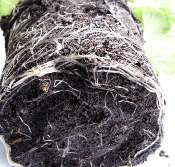 I have been looking for a means to show you a one-size-fits-all method of watering a pot plant. At last we're getting there. This geranium (pelargonium) was purchased in a garden centre five days ago, the healthiest of a bunch, with three growing stems. Rather heavy, though.
I have been looking for a means to show you a one-size-fits-all method of watering a pot plant. At last we're getting there. This geranium (pelargonium) was purchased in a garden centre five days ago, the healthiest of a bunch, with three growing stems. Rather heavy, though. Although recently watered - and thus expected to be heavier - these sparse (compared to the rest) wet roots at the base of the soggy compost reveal it has in fact been over-watered for some time. Pots usually fill with roots from the bottom up. And the tap root circling the base shows this plant has been in the pot for some time. I popped it on the kitchen scales: 13 ounzes (about 370 grams).
Although recently watered - and thus expected to be heavier - these sparse (compared to the rest) wet roots at the base of the soggy compost reveal it has in fact been over-watered for some time. Pots usually fill with roots from the bottom up. And the tap root circling the base shows this plant has been in the pot for some time. I popped it on the kitchen scales: 13 ounzes (about 370 grams).After standing the pot on a splayed out kitchen towel overnight, and leaving for a further day, it then weighed a full 3 ounzes (85 grams) less, a loss of 23%. It has not been watered since.
On the fourth day, it weighed 8 ounzes (226 grams), and the compost was just starting to change colour - about right for growth (for a geranium). We should start seeing some root recovery now. Placing the pot outside in the sun for some of the time has helped it dry out more quickly. We need to watch it carefully now, so it doesn't get too dry and scorch the foliage.
 The fifth day, and there's some root growth starting. About three quarters of the compost has now changed colour. The weight is down to just over 7 ounzes (about 200 grams). We could withold watering another day, or so. But best not. Geraniums don't really droop (unless they're sick). The older leaves just turn brown and crinkly. So gave it a good soak and put outside.
The fifth day, and there's some root growth starting. About three quarters of the compost has now changed colour. The weight is down to just over 7 ounzes (about 200 grams). We could withold watering another day, or so. But best not. Geraniums don't really droop (unless they're sick). The older leaves just turn brown and crinkly. So gave it a good soak and put outside.With water-sensitive plants, I find it best to water first thing in the morning. This way, the pot has time to drain, and the roots can take up any excess water from the compost more quickly, thus eliminating the risk of leaving the roots in soggy compost without air. And because things are generally drier overnight, there is less risk of disease taking hold. It is good policy to keep a pot drier tissue under the pot on a permanent basis. This ensures compost cannot be too wet for too long.
USE ONLY PLAIN WATER - NO FEED
It is important not to feed the plant until it starts to lose colour. The compost will almost certainly already contain some slow release feed which might support growth for a couple of months. There is no way of knowing, unless you see the feed pellets in the compost. Best to be safe. We can soon feed if we have to.
FOLIAGE COLOUR
I like to avoid plants with dark green foliage. This indicates too much nitrogen has been given for firm healthy growth; the growth will have been forced. And contrary to opinion, plants do not seem to grow fastest in this condition. I find a leaf which is mid-green in the centre (the new growth), turning slightly darker towards the edges is the colour which supports optimum growth.
KEEP CHECKING THE ROOTS
Many people are afraid to remove plants from their pots to examine the roots. Don't be. It's the best way to learn how to grow any plant. Just be careful not to damage it. Place stem between fingers and invert pot onto palm, then press the base of the pot with thumb of other hand. Plant falls out of pot onto palm. Easy.
Drying is important. NEVER WATER ANY PLANT UNTIL THERE HAS BEEN AT LEAST SOME DRYING OF THE COMPOST, the more the better. Some plants can be dried out more than others. You will need to experiment.
No comments:
Post a Comment